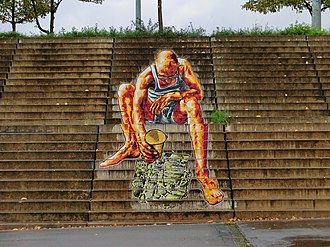Accidental viewpoint
Accidental viewpoint refers to a perspective in photography, visual arts, and design where the subject is seen from an angle that is not commonly used in standard representations. This viewpoint can introduce an element of surprise or novelty, offering a fresh look at familiar subjects. It can also reveal details and aspects of the subject that are not visible from traditional viewpoints. Accidental viewpoints are often employed to create a unique composition, add interest, or convey a specific mood or message.
Overview
In the realm of visual arts, artists and photographers seek to present their subjects in ways that evoke emotion, provoke thought, or simply capture attention. The accidental viewpoint is a powerful tool in achieving these goals. By definition, it involves capturing or depicting a subject from an unusual angle or perspective, which can make the ordinary appear extraordinary. This approach can be deliberate or the result of serendipity, but it always results in a departure from the norm.
Applications
- Photography
In photography, accidental viewpoints can be used to create dynamic and engaging images. Photographers might shoot from high above (bird's eye view) or from very low angles (worm's eye view) to achieve this effect. Such perspectives can make a photograph more intriguing and encourage viewers to engage with the image in a deeper way.
- Visual Arts
Artists in the visual arts utilize accidental viewpoints to challenge viewers' perceptions and to add depth to their work. This can be seen in painting, sculpture, and installation art, where the manipulation of perspective plays a crucial role in the artwork's impact.
- Design
In design, especially in architecture and interior design, accidental viewpoints can influence how spaces are experienced. Architects may design structures with unique angles and forms that change appearance when viewed from different perspectives, enhancing the viewer's interaction with the space.
Techniques
To achieve an accidental viewpoint, photographers and artists might employ a variety of techniques. These include changing their physical position relative to the subject, using mirrors or reflective surfaces to capture unusual reflections, or manipulating lenses and focal lengths to distort perspective.
Impact
The use of accidental viewpoints can significantly impact the viewer's experience. It can make the familiar look unfamiliar, thus renewing interest in the subject. It can also convey a sense of movement or dynamism, adding to the composition's emotional or aesthetic appeal.
Examples
Famous examples of accidental viewpoints can be found in the works of photographers like Henri Cartier-Bresson and artists such as M.C. Escher. Their work often challenges conventional perspectives, inviting viewers to see the world in new and unexpected ways.
Conclusion
Accidental viewpoints offer a unique way to view the world, transforming mundane subjects into objects of fascination. By altering the perspective, artists and photographers can create compelling compositions that stand out and engage the viewer on multiple levels.
Transform your life with W8MD's budget GLP-1 injections from $125.
W8MD offers a medical weight loss program to lose weight in Philadelphia. Our physician-supervised medical weight loss provides:
- Most insurances accepted or discounted self-pay rates. We will obtain insurance prior authorizations if needed.
- Generic GLP1 weight loss injections from $125 for the starting dose.
- Also offer prescription weight loss medications including Phentermine, Qsymia, Diethylpropion, Contrave etc.
NYC weight loss doctor appointments
Start your NYC weight loss journey today at our NYC medical weight loss and Philadelphia medical weight loss clinics.
- Call 718-946-5500 to lose weight in NYC or for medical weight loss in Philadelphia 215-676-2334.
- Tags:NYC medical weight loss, Philadelphia lose weight Zepbound NYC, Budget GLP1 weight loss injections, Wegovy Philadelphia, Wegovy NYC, Philadelphia medical weight loss, Brookly weight loss and Wegovy NYC
|
WikiMD's Wellness Encyclopedia |
| Let Food Be Thy Medicine Medicine Thy Food - Hippocrates |
Medical Disclaimer: WikiMD is not a substitute for professional medical advice. The information on WikiMD is provided as an information resource only, may be incorrect, outdated or misleading, and is not to be used or relied on for any diagnostic or treatment purposes. Please consult your health care provider before making any healthcare decisions or for guidance about a specific medical condition. WikiMD expressly disclaims responsibility, and shall have no liability, for any damages, loss, injury, or liability whatsoever suffered as a result of your reliance on the information contained in this site. By visiting this site you agree to the foregoing terms and conditions, which may from time to time be changed or supplemented by WikiMD. If you do not agree to the foregoing terms and conditions, you should not enter or use this site. See full disclaimer.
Credits:Most images are courtesy of Wikimedia commons, and templates, categories Wikipedia, licensed under CC BY SA or similar.
Translate this page: - East Asian
中文,
日本,
한국어,
South Asian
हिन्दी,
தமிழ்,
తెలుగు,
Urdu,
ಕನ್ನಡ,
Southeast Asian
Indonesian,
Vietnamese,
Thai,
မြန်မာဘာသာ,
বাংলা
European
español,
Deutsch,
français,
Greek,
português do Brasil,
polski,
română,
русский,
Nederlands,
norsk,
svenska,
suomi,
Italian
Middle Eastern & African
عربى,
Turkish,
Persian,
Hebrew,
Afrikaans,
isiZulu,
Kiswahili,
Other
Bulgarian,
Hungarian,
Czech,
Swedish,
മലയാളം,
मराठी,
ਪੰਜਾਬੀ,
ગુજરાતી,
Portuguese,
Ukrainian
Contributors: Prab R. Tumpati, MD




